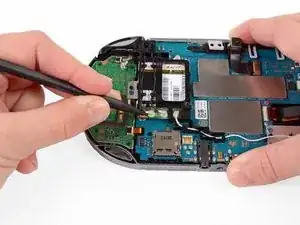The main identifying factor on the PS Vita is the second analog stick and the words PS Vita below the screen.
Released in December of 2011 in Japan and parts of Asia, and February of 2012 in Europe, Australia, and Latin and North America, the Vita added some impressive specs to the previously released versions of PSPs. It sports a 4 core ARM Cortex-A9 MPCore processor, 512 MB RAM, 128 MB VRAM, a 5-inch OLED multi-touch capacitive touchscreen, rear multi-touch capacitive touchpad, and a 4 core SGX543MP4+ graphics card.
The most often replaced PlayStation Vita parts include the battery, motherboard, SIM card reader, and SIM card tray.
- 4 core ARM Cortex-A9 MPCore processor
- 512 MB RAM, 128 MB VRAM
- 5-inch OLED multi-touch capacitive touchscreen
- rear multi-touch capacitive touchpad
- 4 core SGX543MP4+ graphics card
- PlayStation Vita card slot
- SIM card slot (3G/Wi-Fi model only)
- Multi-use port (for USB data communication, DC IN, Audio (Stereo Out /Mono In), Serial data communication), Headset jack (Stereo mini jack) (for Audio (Stereo Out/Mono In))
- Accessory port
- Sound: Built-in stereo speakers, Built-in microphone
- Sensors: Six-axis motion sensing system (three-axis gyroscope, three-axis accelerometer),
- Three-axis electronic, compass
- Location: Built-in GPS (3G/Wi-Fi model only), Wi-Fi location service support
- Power: Built-In Lithium-ion Battery,AC adaptor
- Supported Music: MP3 MPEG-1/2 Audio Layer 3, MP4 (MPEG-4 AAC)
- AV content: WAVE (Linear PCM)
- Videos: MPEG-4 Simple Profile (AAC), H.264/MPEG-4 AVC, High/Main/Baseline Profile (AAC)
- Photos: JPEG (Exif 2.2.1), TIFF, BMP, GIF, PNG
